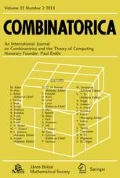Abstract
A partial affine plane (PAP) of ordern is ann 2-setS of points together with a collection ofn-subsets ofS called lines such that any two lines meet in at most one point. We obtain conditions under which a PAP with nearlyn 2+n lines can be completed to an affine plane by adding lines. In particular, we make use of Bruck’s completion condition for nets to show that certain PAP’s with at leastn 2+n−√n can be completed and that forn≠3 any PAP withn 2+n−2 lines can be completed.
Similar content being viewed by others
References
M. R. Best, A. E. Brouwer, F. J. MacWilliams, A. M. Odlyzko andN. J. A. Sloane, Bounds for binary codes of length less than 25,IEEE Trans. Info. Theory 24 (1978), 81–93.
R. H. Bruck, Finite nets II. Uniqueness and imbedding,Pacific J. Math. 13 (1963), 421–457.
S. Dow, An improved bound for extending partial projective planes,Discrete Math. 45 (1983), 199–207.
S. A. Vanstone, The extendibility of (r, 1)-designs,Proc. Third Manitoba Conf. on Numerical Math., Winnipeg (1973), 409–418.




